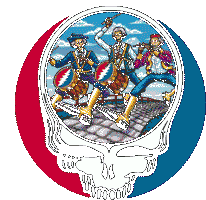
From Poughkeepsie Journal:
Woodstock museum would like your piece of history
Planned site to chronicle key music moment
By John W. Barry
Poughkeepsie Journal
Bethel Woods Center for the Arts is set to expand its offerings next year with a museum, and wants your help as it explores the impact of the 1969 Woodstock Music and Art Fair and the decade in which it occurred.
Bethel Woods, built in Sullivan County where the Woodstock concert was held in August 1969, opened July 1 with a concert by the New York Philharmonic. The performing arts center was built by the Gerry Foundation, a not-for-profit organization run by Sullivan County cable television magnate Alan Gerry.
Set to open in 2007 near an amphitheater that can hold nearly 17,000 is a 10,000-square-foot museum with multimedia exhibits built around music, film and interactive computers. The museum will probe the social, political and cultural climate of the 1960s and celebrate what many consider the counter-culture's crowning achievement of that era — the Woodstock concert.
From the people
Mike Egan, chief executive officer of the Museum Development Group for the Gerry Foundation, said a critical piece of the museum will be mementos, artifacts, photographs and other items from the concert and the era that people have kept over the years.
Bethel Woods is asking anyone who collects these items or has them stored in an attic or basement to contact the arts center through www.bethelwoodslive.org.
Bethel Woods through Nov. 30 will consider these items for inclusion in its museum.
Egan said this call for Woodstock artifacts underscore's the Gerry Foundation's position that the story behind Woodstock is as much about the people who attended, worked and felt the first-hand impact of the concert as it was about the headlining musicians who performed.
The goal of the museum, he said, is to celebrate the concert and interpret it within the context of the times.
"It's not supposed to be a history lesson," Egan said of the museum. "We want to tell the story of how the concert happened and why."
The museum will feature a 130-seat movie theater with stadium seating and an additional 6,000 square feet of space for traveling exhibits. Also, 10 video projectors will screen images on a separate, curved wall that is 28 feet high.
"Hopefully, you'll feel like you were in the audience or on the stage," Egan said.
Bethel Woods has secured footage that was shot for the Academy Award-winning documentary about the concert — both seen and unseen — through an arrangement with Warner Bros.
The History Channel is creating a documentary on 1968 — the year in which Robert F. Kennedy and the Rev. Martin Luther King Jr. were assassinated — for the museum. Also, two people directly involved in the opening of the Rock and Roll Hall of Fame in Cleveland are consultants on the project.
Underscoring the human element of the museum's mission are video testimonials from a wide range of people, including an attorney who helped secure government approval for the gathering, one of those who built the stage and another involved with booking the bands.
Also captured on video are Wavy Gravy, who along with the Hog Farm commune helped feed hundreds of thousands of concert-goers, former Grateful Dead bass player Phil Lesh, Country Joe McDonald and Johnny Winter, who all performed at Woodstock. The video interviews will be featured in the museum.
Donated security jacket
Joe Scarda, 69, was a New York City police officer when he and his colleagues took side jobs working security at Woodstock. He donated the red Woodstock security jacket he was issued and sat for a video interview.
"We had our own ideas what hippies were like, but we never interacted with them until I went up there," said Scarda, who ended up relocating to Sullivan County. "I never saw a bloody nose. They were so peaceful. It was really a love-in."
Gerry Foundation Executive Director Jonathan Drapkin said public interest in the Woodstock phenomenon is steady. Over eight weekends during the summer, Drapkin said, 2,100 people from 24 states and 16 countries visited a monument to the concert located on the northwest corner of the Woodstock property, not far from the performing arts center and museum site.
"People come every day of the year, from all around the world and make a pilgrimage to this site," Egan said. "It's a very historic site."
John W. Barry can be reached at jobarry@poughkeepsiejournal.com



0 Comments:
Post a Comment
<< Home